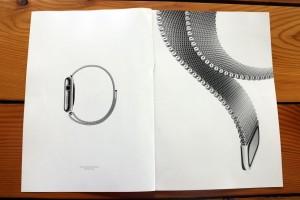Apple faced an uphill battle marketing with the Apple Watch. Wearable consumer tech is still a relatively new phenomenon, at least where typical  smartphone functions are concerned. Other leaders like LG actually released their own smart watches before Apple even started promoting theirs. Marketers puzzled over the initially slow and pace of the Apple Watch marketing campaign, but Apple may just have been living by the maxim “slow and steady wins the race.”
smartphone functions are concerned. Other leaders like LG actually released their own smart watches before Apple even started promoting theirs. Marketers puzzled over the initially slow and pace of the Apple Watch marketing campaign, but Apple may just have been living by the maxim “slow and steady wins the race.”
The tremendous patience and control with which Apple introduced its Apple Watch to the world is a big reason Apple Watch is our IMC Campaign of the Month.
While LG, Samsung and other competitors hit the ground running with typical multi-channel campaigns to reach the widest possible (yet still viable) audience, Apple held off, teasing the world first with a 12 page ad in Vogue magazine. One very specific audience: fashionistas.
Marketers started buzzing about why Apple was marketing the Apple Watch specifically to women. The fact that the highest end Apple Watch costs $17,000 might have something to do with the choice of outlet – people reading 12 page Apple ads alongside stories about Manolo Blahnik or Valentino probably don’t blush at high ticket items.
But not all readers of Vogue are able to afford the things they read about in the magazine – many read about them and dream big, yet unattainable dreams. With the Apple Watch’s least expensive version costing just $350, suddenly a sexy, highly fashionable, highly valued item becomes much more affordable for the average consumer. A series of cover photographs of popular models wearing the Smart Watch cemented its image as functional fashion. When a trend is sparked with fashionistas, it becomes visible just about everywhere – from the arms of celebrities to the arms of fashion bloggers. Before you know it, everybody wants one.
Of course the readers of Vogue alone weren’t going to fuel the fire for Apple Watch, so Apple’s measured integrated campaign unfolded with a sleek television ad that looked more like a live demo of the watch’s features. This was followed by a series of interviews with Apple execs, bringing PR into the mix. What Apple did so brilliantly in with PR was let advertising lead a two-pronged approach. Tech media, of course, wanted to talk about the Apple Watch because it was an Apple product, an electronic gadget, in an emerging technology. Fashion media wanted to talk about it because it was suddenly competing not just with other smart watches, but with luxury watches.
In other words, Apple took the “geek” out of this technology, and made it sexy for everyone.
As the campaign gained momentum, social media went into high gear – especially when Apple saw competitors timing the ads for their own smart watches around the launch event for the Apple Watch. Warring Twitter ads between Apple and Pebble, for example, showed how intense the battle for consumer attention can be when competing companies are rushing to capitalize on a new technology at the same time.
The end result was that Apple captured roughly 75.5% of the global smart watch market during its launch quarter. According to Apple CEO Tim Cook, sales of the Apple Watch during its first 9 weeks on the market exceeded the sales of their original iPhone and iPad products when they launched. Those are pretty remarkable results.
Beyond the application of multiple channels integrating perfectly – the ultimate magic of IMC – Apple showed us something that goes back to the very foundation of a firm IMC plan. Apple paid attention to the audiences they wanted to target. They knew where and when and how to reach them. And instead of picking just one, fairly typical audience – i.e. the mostly male demographic who loves geeky gadgets – Apple targeted multiple audiences. In essence, Apple had multiple buyers in mind. One that would probably buy their product anyway, and the other, female fashionistas, that may have been more attracted to a luxury watch from a high fashion brand. It was a gamble, but one that paid off.
